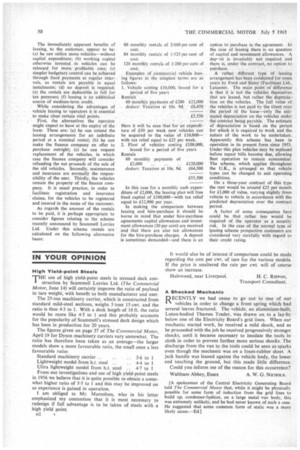IN YOUR OPINION
Page 52

If you've noticed an error in this article please click here to report it so we can fix it.
High Yield-point Steels
'THE use of high yield-point steels in stressed deck construction by Scammell Lorries Ltd. (The Commercial Motor, June 14) will certainly improve the ratio of payload to tare weight, with benefit to both manufacturer and user. The 25-ton machinery carrier, which is constructed from standard mild-steel sections, weighs 5 tons 15 cwt. and the ratio is thus 4.3 to 1. With a deck length of 18 ft. the ratio would be more like 4.5 to 1 and this probably accounts for the popularity of Scammell's stressed deck design which has been in production for 20 years.
The figures given on page 37 of The Commercial Motor, April 19 for Dyson machinery carriers vary somewhat. The ratio has therefore been taken as an average—the larger models show a more favourable ratio, the small ones a less favourable ratio: Standard machinery carrier .. .. 3.6 to 1 Lightweight model from h.t. steel .. .. 4.4 to 1 Ultra lightweight model from h.t. steel .. 4.7 to 1 From our investigations and use of high yield-point steels in 1956 we believe that it is quite possible to obtain a somewhat higher ratio of 5.5 to 1 and this may be improved on as experience is gained in operation.
I am obliged to Mr. Marenbon, who in his letter emphasized my contention that it is most necessary to redesign if full advantage is to be taken of steels with a high yield point.
It would also be of interest if comparison could be made regarding the cost per cwt. of tare for the various models. If the price is unaltered the rate per cwt. will of course show an increase.
Halewood, near Liverpool. H. C. RIPPON,
Transport Consultant.
A Shocked Mechanic ECENTLY we had cause to go out to one of our vehicles in order to change a front spring which had several leaves fractured. The vehicle, an aluminium-built, Luton-bodied Thames Trader, was drawn on to a lay-by below one of the Electricity Board's grid lines. When our mechanic started work, he received a mild shock, and as he proceeded with the job he received progressively stronger shocks, until it became necessary to insulate the tools in cloth in order to prevent further more serious shocks. The discharge from the van to the tools could be seen as sparks even though the mechanic was on a foam-rubber sheet. A jack handle was leaned against the vehicle body, the lower end touching the ground, but this made little difference. Could you inform me of the reason for this occurrence?
Waltham Abbey, Essex A. W. G. NICHOLS.
[A spokesman of the Central Electricity Generating Board told The Commercial Motor that, while it might be physically possible for some form of induction from the grid lines to build up, condenser-fashion, on a large metal -van body, this was extremely unlikely, and he had never known of such a case. He suggested that some common form of static was a more likely oause.—Ed.1












































































































